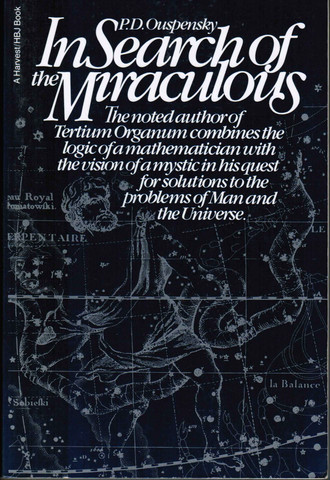Part of the Casswiki article series Books

In Search of the Miraculous: Fragments of an Unknown Teaching is a book by P. D. Ouspensky, published posthumously in 1949 by Ouspensky’s students and authorized by George Gurdjieff himself. It is probably the best overall introduction to the Fourth Way ever published, containing both a structured presentation of the teaching and a personal account giving background information and additional perspective.
The book is essentially Ouspensky’s account of how he met “G.” (who we know to be Gurdjieff), learned his Fourth Way teaching, and in what this teaching consisted. It relates events starting with Ouspensky’s encounter with Gurdjieff in Moscow in 1915. Ouspensky then describes his participation in Gurdjieff’s Work groups, recording both his experiences and the concepts Gurdjieff gave in his lectures in a roughly chronological order.
From the viewpoint of the FOTCM, this book is packed with profound information and is a good general introduction to Gurdjieff’s ideas, and also gives a good glimpse of how Gurdjieff did things. Part of this approach, as well as several other Gurdjieffian ideas, are an integral part of FotCM. It remains an essential read for understanding a number of the topics discussed on the Cassiopaea Forum – as well as for anyone seriously interested in The Work, i.e. in practicing the Fourth Way.
In relation to other Fourth Way books
- Boris Mouravieff’s Gnosis “Gnosis (book trilogy)”) trilogy makes good additional reading; it provides additional information on the teaching, but lacks the more concrete perspective conveyed by Ouspensky’s personal account. It is also best kept in mind that Mouravieff sometimes made overly literal interpretations, gave his writing something of a “Biblical gloss”, and at times displayed prejudice and identification with ideas such as Synarchism. Read critically, his work however serves as a conceptual bridge between the work of Gurdjieff and the Cassiopaean material.
- Writings by Gurdjieff himself are generally more difficult and less explicit; Ouspensky’s great contribution to the Work has been to gather the concepts into a relatively concise and structured package. Many specific points of Gurdjieff’s teaching are only recorded in writings by his followers. If they are found in Beelzebub’s Tales to His Grandson, they are often presented in a more difficult form requiring more familiarity with the Work for extracting them from the text.
- William Patrick Patterson’s [Georgi Ivanovitch Gurdjieff: The Man, The Teaching, His Mission](Georgi Ivanovitch Gurdjieff -The Man, The Teaching, His Mission) is recommended for a deeper exploration of the history of the work of Gurdjieff and his students – the events, the people, and some perspective on the teaching. Such understanding can increase the appreciation and practical understanding of the teaching, in the same way as Ouspensky’s account in his book accomplishes.
- Ouspensky’s works also include the following books on the Fourth Way: The Psychology of Man’s Possible Evolution, The Cosmology of Man’s Possible Evolution, The Fourth Way, and A Further Record: Extracts from Meetings 1928–1945. These books can be useful as supplementary material, but their content and presentation is more based on Ouspensky’s interpretation of the Fourth Way, compared to the mostly highly accurate account of what Gurdjieff taught that is found in In Search of the Miraculous.
- Other students of Gurdjieff, and students of students of Gurdjieff, etc., have written their own books, but these are generally skewed by personal biases and misunderstandings to a greater or lesser extent, and are therefore best taken with a grain of salt.
